Kawasaki Heavy Industries Bundle
How is Kawasaki Heavy Industries Riding the Wave of Innovation and Profit?
From shipbuilding to cutting-edge motorcycles and aerospace, Kawasaki Heavy Industries (KHI) has evolved dramatically since its inception in 1896. This transformation showcases a dynamic shift from its initial maritime focus to a solutions-driven approach, constantly adapting to meet evolving customer needs. With ambitious growth targets set for 2030, understanding KHI's sales and marketing strategies is crucial for anyone looking to understand the future of this industrial giant.
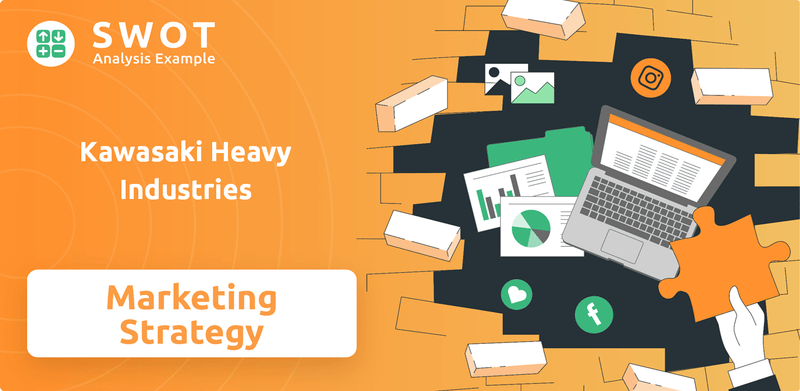
This analysis dives deep into the Kawasaki Heavy Industries SWOT Analysis, exploring its sales channels, marketing tactics, and brand positioning. We will examine how Kawasaki's diverse product portfolio, from motorcycles to industrial equipment, is strategically marketed to achieve its financial goals. This report provides crucial insights into Kawasaki's sales strategy and marketing approach, helping investors and strategists understand its competitive advantage and future prospects through detailed market analysis.
How Does Kawasaki Heavy Industries Reach Its Customers?
The sales channels of Kawasaki Heavy Industries (KHI) are multifaceted, utilizing both online and offline platforms to reach a diverse global customer base. For consumer products, particularly motorcycles, KHI relies on a global dealership network complemented by expanding online sales. This omnichannel approach allows the company to cater to various consumer segments and respond quickly to market needs across over 90 countries and regions.
In its industrial and heavy equipment segments, KHI employs a multi-channel approach. This includes direct sales teams, wholesale distributors, and partner retailers. These channels are crucial for delivering specialized equipment for industrial, construction, agriculture, and marine markets. The company strategically uses its sister companies for distribution in key markets like the US, Japan, Korea, India, and China.
The evolution of these channels reflects KHI's strategic shifts. Historically, KHI has favored short distribution channels. Recent investments, such as the allocation of over JPY30 billion by 2025 to double production capacity for Recreational Off-highway Vehicles (ROVs), and the operationalization of a new plant in Mexico in December 2023, underscore a strategic shift towards strengthening production capacity and localization to support growth in key markets. The motorcycle business is also expected to grow with the new plant in Mexico and new model introductions. These strategic investments and channel optimizations are vital for Kawasaki to maintain its competitive edge.
Kawasaki's primary sales channel for motorcycles is its global dealership network. This network is crucial for reaching consumers worldwide. The dealerships offer sales, service, and support, enhancing the customer experience.
KHI is expanding its online sales platforms to cater to a broader audience. This complements the dealership network, offering convenience and wider reach. The online presence allows for direct sales and increased brand visibility.
For industrial and heavy equipment, KHI uses a multi-channel approach. This includes direct sales teams, wholesale distributors, and partner retailers. This strategy ensures specialized equipment reaches the right markets.
Kawasaki Precision Machinery UK, for example, uses 44 distribution partners across Europe, the Middle East, South Africa, and Australia. Sister companies also play a role in distributing products in key markets. This approach enhances market penetration.
Recent investments and strategic shifts highlight Kawasaki's commitment to growth and market adaptation. The allocation of over JPY30 billion to double ROV production capacity by 2025 shows a focus on expanding in key markets. The new plant in Mexico, operational since December 2023, supports this expansion, with the motorcycle business also expected to grow.
- The motorcycle business saw a slight decline of 1.1% in global registrations in 2024, ending the year with 478,125 registrations.
- Europe experienced outstanding performance with a 20.6% increase, and East Europe saw a 68.3% increase.
- Sales also increased in double-digits in Latin America.
- KHI aims to achieve a projected revenue of 2,310 billion yen for fiscal year 2025, an 8% increase from the previous period.
Kawasaki Heavy Industries SWOT Analysis
- Complete SWOT Breakdown
- Fully Customizable
- Editable in Excel & Word
- Professional Formatting
- Investor-Ready Format
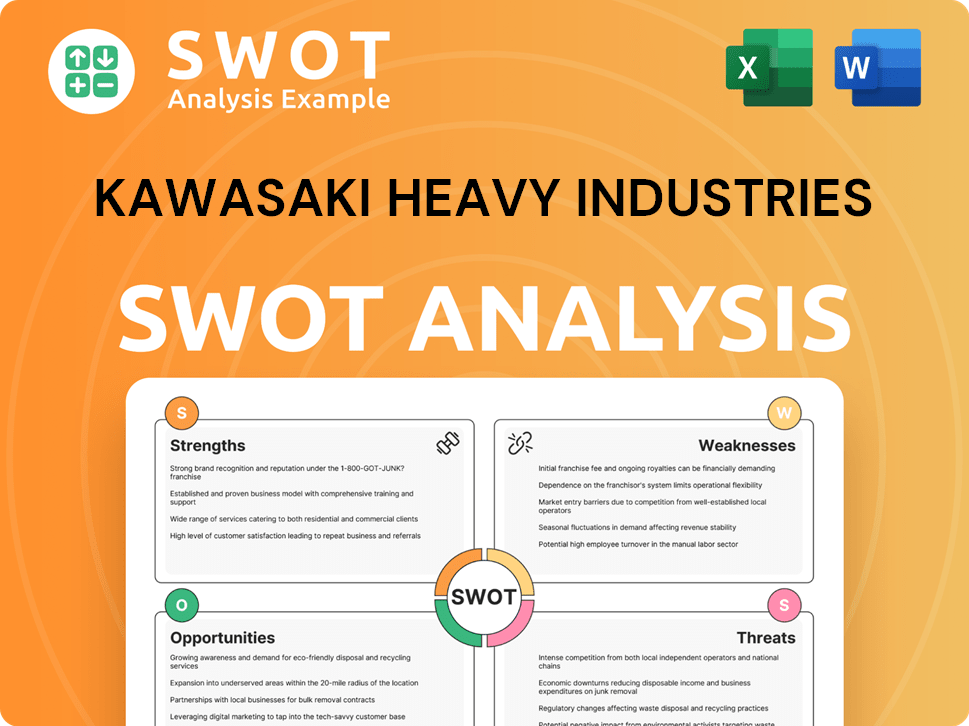
What Marketing Tactics Does Kawasaki Heavy Industries Use?
The marketing tactics employed by Kawasaki Heavy Industries (KHI) are diverse, reflecting its broad product portfolio and varied target audiences. The Kawasaki marketing strategy leverages both traditional and digital channels to build brand awareness and drive sales. Their approach is tailored to specific segments, such as motorcycles and industrial equipment, ensuring effective communication and engagement.
For consumer products, particularly motorcycles, Kawasaki focuses heavily on digital marketing, promotional campaigns, and social media engagement. This approach aims to attract younger audiences and build brand loyalty. For industrial and heavy equipment, marketing efforts highlight technological advancements and product innovation, showcasing the company's commitment to cutting-edge solutions.
Kawasaki's marketing mix has evolved to support its strategic goals, including sustainability and environmental responsibility. The company's investments in renewable energy projects and the development of electrified and hydrogen-powered engines for motorcycles demonstrate its commitment to decarbonization and green technology, which is a key element of its current marketing efforts.
Kawasaki utilizes digital marketing extensively, particularly for its consumer products like motorcycles. This includes search engine optimization (SEO), paid advertising, email marketing, and influencer partnerships.
Promotional campaigns are a key part of Kawasaki's strategy, using both traditional and digital media. These campaigns aim to increase brand visibility and drive sales across various product lines.
Kawasaki actively uses social media to engage with its target audiences, particularly younger consumers. This includes creating content and running campaigns on platforms like Instagram and Facebook.
For industrial and heavy equipment, Kawasaki emphasizes technological advancements and product innovation. This includes highlighting new technologies and features to attract business customers.
Kawasaki leverages advanced IT technology and data from social networking channels and IoT sensors to refine and develop products. This data-driven approach helps them understand market needs and customer preferences.
Kawasaki integrates sustainability into its marketing, promoting its green technologies and environmental initiatives. This includes the development of electrified and hydrogen-powered engines for motorcycles.
The Kawasaki sales strategy and Kawasaki marketing strategy are designed to support its diverse business segments. The company's approach includes a focus on digital marketing, promotional campaigns, and sustainability initiatives. Kawasaki's Kawasaki business model and Kawasaki product portfolio are supported by these marketing tactics.
- Digital Marketing: Extensive use of SEO, paid advertising, email marketing, and influencer partnerships.
- Promotional Campaigns: Advertising across traditional and digital media to increase brand visibility.
- Social Media: Active engagement on social media platforms to connect with target audiences.
- Technological Advancements: Highlighting product innovation and technological features in marketing materials.
- Data-Driven Insights: Utilizing data from social media and IoT sensors to refine products and understand market needs.
- Sustainability: Promoting green technologies, such as electric and hydrogen-powered engines, to align with environmental goals.
Kawasaki Heavy Industries PESTLE Analysis
- Covers All 6 PESTLE Categories
- No Research Needed – Save Hours of Work
- Built by Experts, Trusted by Consultants
- Instant Download, Ready to Use
- 100% Editable, Fully Customizable
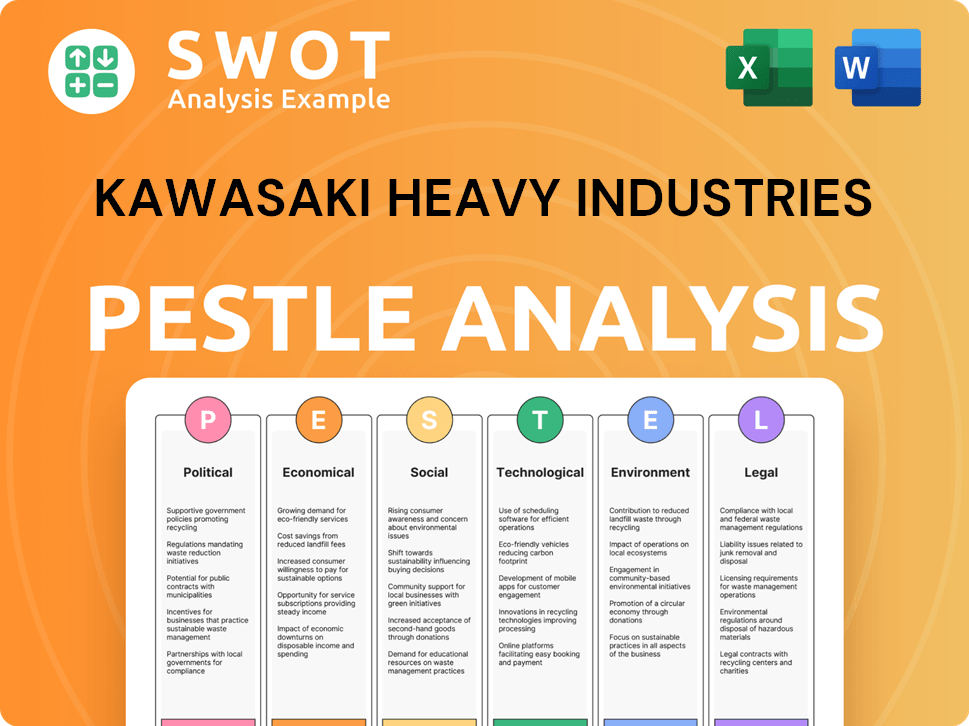
How Is Kawasaki Heavy Industries Positioned in the Market?
Kawasaki Heavy Industries (KHI) strategically positions itself as a global leader across diverse heavy industries. This is achieved by emphasizing innovation, technological advancement, and a commitment to quality and sustainability. The company leverages its rich history, dating back over a century and a half, to build a strong brand identity, especially in sectors like aerospace and rail.
The company's brand positioning is multifaceted, catering to different segments with tailored approaches. For instance, in the high-performance motorcycle market, a premium pricing strategy is employed to reflect the advanced technology and superior performance of models. Conversely, for entry-level and mid-range motorcycles, the company adopts competitive pricing to attract a broader customer base.
KHI's approach extends to its industrial and heavy equipment segments, where it prioritizes a 'Customer First' philosophy. This is demonstrated through a customer satisfaction index of 87% and the launch of a new customer portal in 2024, which has increased customer engagement by 25%. Furthermore, the brand highlights its commitment to environmental sustainability, aiming to reduce greenhouse gas emissions by 30% by 2030.
KHI's brand identity is built on a legacy of over a century and a half, emphasizing engineering excellence. This history, which includes pioneering achievements like building Japan's first airplane, underpins its reputation.
KHI targets its audience through a multi-faceted approach, including premium pricing for high-performance motorcycles and competitive pricing for entry-level models. This segmented strategy ensures broad market appeal.
The 'Customer First' philosophy is central to KHI's brand positioning, especially in industrial and heavy equipment segments. This commitment is reflected in high customer satisfaction and increased engagement.
KHI is committed to environmental sustainability, with a goal to reduce greenhouse gas emissions by 30% by 2030. This highlights the brand's focus on environmental responsibility.
Brand consistency is maintained through a clear mission statement and a vision for 2024 that focuses on global expansion and innovation. KHI responds to market shifts by continuously investing in R&D, with an expenditure of ¥40 billion (approximately $300 million) in 2023, to lead in advanced technologies. The company's strong presence and operational efficiency, along with strategic collaborations, further solidify its competitive advantage. For more insights, you can explore Owners & Shareholders of Kawasaki Heavy Industries.
Kawasaki Heavy Industries Business Model Canvas
- Complete 9-Block Business Model Canvas
- Effortlessly Communicate Your Business Strategy
- Investor-Ready BMC Format
- 100% Editable and Customizable
- Clear and Structured Layout
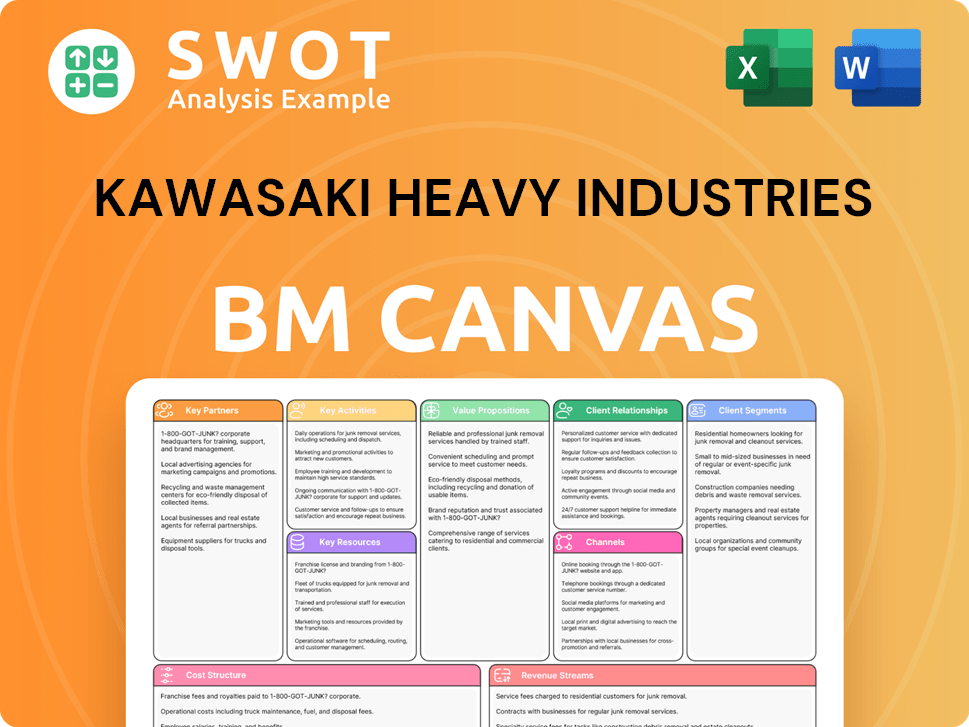
What Are Kawasaki Heavy Industries’s Most Notable Campaigns?
Kawasaki Heavy Industries has launched significant campaigns that highlight its technological advancements and commitment to sustainable solutions. These efforts are designed to enhance its Kawasaki sales strategy and strengthen its position in various markets. The company's approach includes product innovation and strategic marketing initiatives to drive growth and brand recognition.
A key campaign involves the HySE-X1, a hydrogen-engine buggy that participated in the Dakar Rally in January 2024. This initiative aimed to test hydrogen engine technology and support decarbonization efforts, showcasing Kawasaki's leadership in the field. This campaign is a prime example of the Kawasaki marketing strategy focusing on innovation and future-oriented technologies.
In the motorcycle segment, Kawasaki has introduced groundbreaking models, including the world's first strong hybrid motorcycle in 2024. These launches are part of a broader strategy to introduce new models and advance towards carbon neutrality. The company's Kawasaki business model emphasizes innovation and sustainability.
The HySE-X1, a hydrogen-engine buggy, participated in the Dakar Rally in January 2024. This campaign aimed to test hydrogen engine technology and build fundamental technology for hydrogen engines. The successful completion of the rally demonstrated Kawasaki's commitment to next-generation powertrains.
Kawasaki launched the world's first strong hybrid motorcycle in 2024. This launch is a key part of the company's strategy to introduce new models and advance towards carbon neutrality. It reinforces Kawasaki's image as an innovator in sustainable mobility.
Kawasaki's campaigns highlight its commitment to hydrogen engine technology. These efforts demonstrate the company's pioneering spirit in developing next-generation powertrains. This focus aligns with the broader trend toward sustainable energy solutions.
Kawasaki utilizes engaging promotional campaigns and a strong social media presence to attract younger audiences. This digital strategy supports the Kawasaki marketing strategy by building brand awareness and customer engagement. This approach is a key element of their digital marketing strategy.
Kawasaki's financial results for fiscal year 2024 (ending March 31, 2025) indicate a positive outlook. The company forecasts record-high revenue exceeding ¥2 trillion and business profit over ¥100 billion. This growth is driven by increased sales across multiple segments, including marine machinery, energy, and plant businesses. Kawasaki's target market and its sales performance analysis are key factors in this success.
- Record-high revenue exceeding ¥2 trillion is projected for fiscal year 2024.
- Business profit is forecast to exceed ¥100 billion.
- Growth is driven by increased sales in marine machinery, energy, and plant businesses.
- These figures reflect the effectiveness of the Kawasaki Heavy Industries sales and marketing approach.
Kawasaki Heavy Industries Porter's Five Forces Analysis
- Covers All 5 Competitive Forces in Detail
- Structured for Consultants, Students, and Founders
- 100% Editable in Microsoft Word & Excel
- Instant Digital Download – Use Immediately
- Compatible with Mac & PC – Fully Unlocked
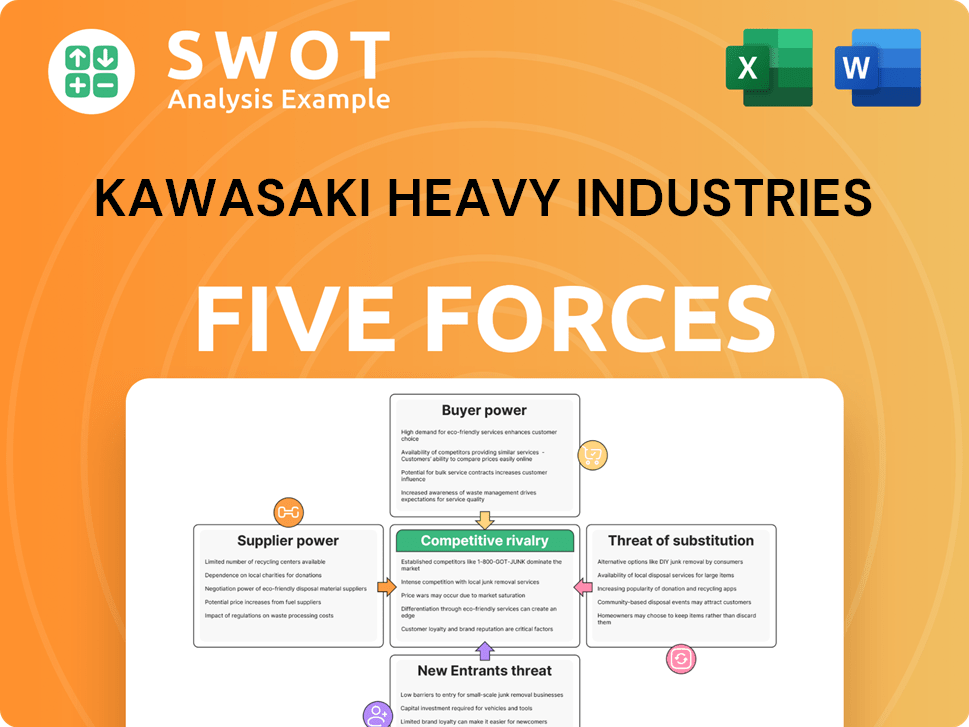
Related Blogs
- What are Mission Vision & Core Values of Kawasaki Heavy Industries Company?
- What is Competitive Landscape of Kawasaki Heavy Industries Company?
- What is Growth Strategy and Future Prospects of Kawasaki Heavy Industries Company?
- How Does Kawasaki Heavy Industries Company Work?
- What is Brief History of Kawasaki Heavy Industries Company?
- Who Owns Kawasaki Heavy Industries Company?
- What is Customer Demographics and Target Market of Kawasaki Heavy Industries Company?
Disclaimer
All information, articles, and product details provided on this website are for general informational and educational purposes only. We do not claim any ownership over, nor do we intend to infringe upon, any trademarks, copyrights, logos, brand names, or other intellectual property mentioned or depicted on this site. Such intellectual property remains the property of its respective owners, and any references here are made solely for identification or informational purposes, without implying any affiliation, endorsement, or partnership.
We make no representations or warranties, express or implied, regarding the accuracy, completeness, or suitability of any content or products presented. Nothing on this website should be construed as legal, tax, investment, financial, medical, or other professional advice. In addition, no part of this site—including articles or product references—constitutes a solicitation, recommendation, endorsement, advertisement, or offer to buy or sell any securities, franchises, or other financial instruments, particularly in jurisdictions where such activity would be unlawful.
All content is of a general nature and may not address the specific circumstances of any individual or entity. It is not a substitute for professional advice or services. Any actions you take based on the information provided here are strictly at your own risk. You accept full responsibility for any decisions or outcomes arising from your use of this website and agree to release us from any liability in connection with your use of, or reliance upon, the content or products found herein.